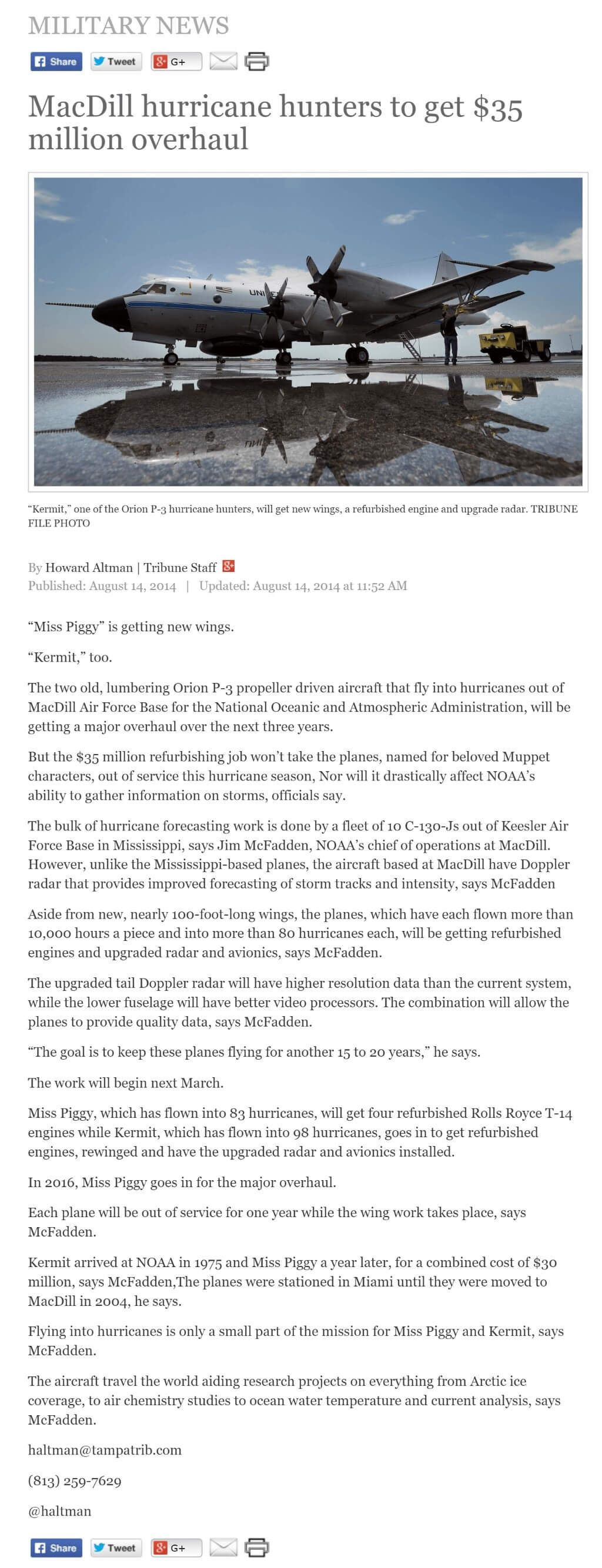
“Miss Piggy” is getting new wings.
“Kermit,” too.
The two old, lumbering Orion P-3 propeller driven aircraft that fly into hurricanes out of MacDill Air Force Base for the National Oceanic and Atmospheric Administration, will be getting a major overhaul over the next three years.
But the $35 million refurbishing job won’t take the planes, named for beloved Muppet characters, out of service this hurricane season, Nor will it drastically affect NOAA’s ability to gather information on storms, officials say.
The bulk of hurricane forecasting work is done by a fleet of 10 C-130-Js out of Keesler Air Force Base in Mississippi, says Jim McFadden, NOAA’s chief of operations at MacDill. However, unlike the Mississippi-based planes, the aircraft based at MacDill have Doppler radar that provides improved forecasting of storm tracks and intensity, says McFadden
Aside from new, nearly 100-foot-long wings, the planes, which have each flown more than 10,000 hours a piece and into more than 80 hurricanes each, will be getting refurbished engines and upgraded radar and avionics, says McFadden.
The upgraded tail Doppler radar will have higher resolution data than the current system, while the lower fuselage will have better video processors. The combination will allow the planes to provide quality data, says McFadden.
“The goal is to keep these planes flying for another 15 to 20 years,” he says.
The work will begin next March.
Miss Piggy, which has flown into 83 hurricanes, will get four refurbished Rolls Royce T-14 engines while Kermit, which has flown into 98 hurricanes, goes in to get refurbished engines, rewinged and have the upgraded radar and avionics installed.
In 2016, Miss Piggy goes in for the major overhaul.
Each plane will be out of service for one year while the wing work takes place, says McFadden.
Kermit arrived at NOAA in 1975 and Miss Piggy a year later, for a combined cost of $30 million, says McFadden,The planes were stationed in Miami until they were moved to MacDill in 2004, he says.
Flying into hurricanes is only a small part of the mission for Miss Piggy and Kermit, says McFadden.
The aircraft travel the world aiding research projects on everything from Arctic ice coverage, to air chemistry studies to ocean water temperature and current analysis, says McFadden.
PHOTO “Kermit,” one of the Orion P-3 hurricane hunters, will get new wings, a refurbished engine and upgrade radar. TRIBUNE FILE PHOTO
